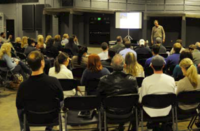Concrete artisans have the wherewithal to market themselves in some unusual ways. Take for instance Cory Hanneman’s ideas for getting the name of his company, Element 7 Concrete Designs in Marble Falls, Texas, out in front of his clients. He made drink coasters out of a urethane mold and self-leveling cement mix. He also used self-consolidating concrete to make a Bakugan game for clients with young children. These out-of-the-box ideas can definitely be memorable, but sometimes it’s the tried-and-true marketing practices that can make the most long-term difference.
Gather testimonials
Once you complete a job and you know the client is happy, follow up over the phone or through email to ask for a testimonial or quote for your website or a brochure. To make things even more convenient, send a stamped postcard they can easily mail back to you.
“Most people simply don’t ask, so ask for testimonials and follow up on it,” says Nekhia Christian, owner and content strategist at And Update My Website, a marketing firm in Eugene, Oregon. “You may have to ask multiple times.” Christian suggests you ask specific, focused questions about your work, which will probably yield better results than simply asking someone for a “testimonial.”
Genuine testimonials give you credibility. When displaying testimonials, the more detail you can provide about the work and about the person giving the testimonial the better. “Pairing quotes with a photo of the client or the job is ideal,” says Christian. Anonymous quotes don’t hold the same weight. Use longer quotes if you can, because a page of selective one-liners such as “great work” or “will use again” doesn’t come across as authentic. And never ever be tempted to write fake testimonials — people can sense it.
Keep your website up to date
Think of website updates as akin to changing the oil in your car. While you can ignore it for a long time, the performance is going to keep declining until you deal with it. “And if you wait too long, the repair costs will be considerable,” says Christian.
By keeping your website current, you convey to every site visitor that you are still in business and available for work. Keep your dates current. Check your “About Us” page for outdated information. For instance, if it says, “I started this business three years ago” and that was in 2008, it’s time to update!
From the technical side of things, search engines such as Google love fresh content. “The more often you update your website by adding content to it in the form of words and pictures, the more often the major search engines will visit your website,” explains Christian. “Over time, a search engine will display your website over others not updated as frequently.”
Add photos and words about every job you finish. Search engines can’t see pictures, so make sure you include a few sentences with keywords — such as “stamped concrete patio” or “textured concrete walkway” — along with the pictures.
Gather high-resolution photos
High-resolution photos are required for sharp reproduction in printed publications. While in-focus lower-resolution photos may look fine online, they don’t have that same quality when reproduced on paper. “It really does pay to invest in a quality camera,” says Janelle Frazier, a graphic designer with Oh So Graphic in Eugene, Oregon. “You can get a nice camera for $300. Snapping a picture with your iPhone or tablet works for sending pictures through email, but with good, reproducible photos you can use them in print, on the web or send them to the media.” To Concrete Decor, for instance.
If you have a camera, go into the settings and do two things. First, remove the date stamp. It blocks elements of your photos and looks unprofessional.
Second, adjust your image settings to large. “This setting refers to the pixel dimensions,” says Frazier. “It tells the width and height of your image in pixels, which are like the digital building blocks of the photo. The more pixels your image contains, the more detail the image can convey.” High-resolution images can be easily converted to smaller, lower-resolution images but not the other way around.
Taking large pictures will cause the images to take up more space on your memory card. “For convenience, get a larger memory card so you can store more photos, or download them to your computer and remove them from your camera on a regular basis so you always have room for more,” says Frazier. It also doesn’t hurt to have more than one card.
Encourage referrals
Working on getting referrals can be difficult, especially for the owner-operator who is busy running the day-to-day operations. Fostering good customer service and doing a great job is the first step in encouraging referrals.
“If you have really good product and you do a great job, people are going to want to share and talk about it,” says Alma Hesus, communications specialist at Cappelli Miles, a full-service marketing firm in Eugene.
Engage them in being part of your team, says Hesus. “That means leaving extra business cards with them and explicitly saying that you would appreciate them telling others about your work.”
Make it easy for your information to be shared. “Take photos of the work you did for them. If it’s appropriate, ask them if they would be in a few of the photos and tell them where you will use the images. You always want permission before posting anything online,” Hesus says. “People love to say, ‘Hey, I was on this website and they talked about me.’”
Connect with the media
Concrete Decor welcomes information and high-resolution pictures about the jobs you’ve done. But don’t limit your media communications just to us.
Find out who covers the business beat for the local newspaper and television stations in your area and develop a relationship with them. Send them pictures and information about your work and your events.
“Let them know you can be a resource for concrete- or construction-related articles, even if it’s not directly covering your work,” says Hesus. “Connect with people in your area who are passionate about it or have some sort of connection to your industry and develop a relationship.”
Ease-of-use is key to communicating with the media. Provide the most important information — who, what, when, where, why and how — upfront. “Make it as easy as possible, so they have all the pieces they need to talk to you,” she says.















